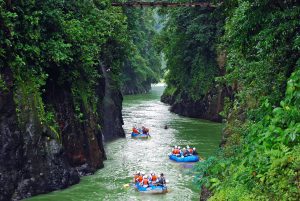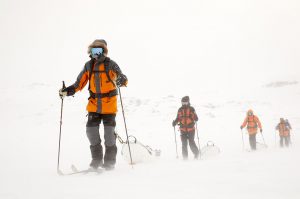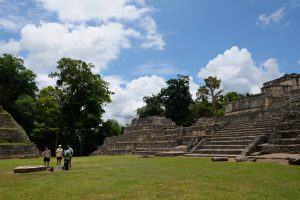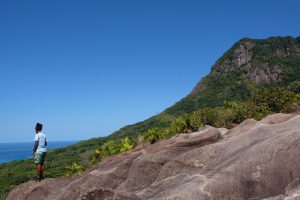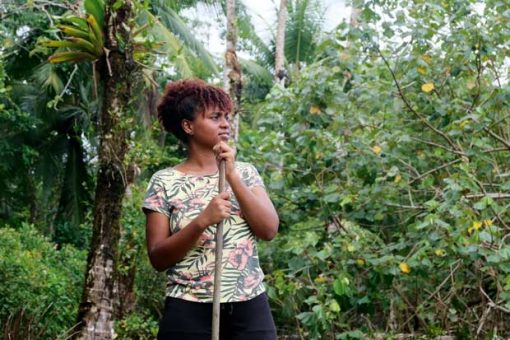
The isolated Pacific villages in the north of Chocó province cry out to those who dream of being cast away. From the equatorial rainforest to the Pacific ocean, this is one of Colombia’s last truly off-grid corners
View online at natgeotraveller.co.uk
There’s a place I walk to each morning when I wake up, jet lagged, at daybreak. I tiptoe from my cabaña, past hammocks and fishermen testing their lines, along molten-silver sands wet from a night-long deluge. I clamber up and over a rock pool. I skirt driftwood exhumed on the last high tide. I follow the snagging coastline, feeling on my bare soles the crisp spines of fallen palm fronds, half-buried in the sand like some giant creature lying in a shallow grave. I walk and walk, and don’t meet another soul, and then it’s there: a mile of rugged, empty beach facing the dawn.
This morning, the Pacific is living up to its name. Peaceful. The light is diffuse; the water fades through deep blue and leaden grey to the darkish lip of the horizon. Little waves lisp and drag at the shore. I’ve never felt so far from home, so blissfully marooned. At my back, the jungle comes crashing down from volcanic hills and then stops in its tracks, like me, to look out across the ocean. And together, the forest and I witness a miracle. In the distance, atop the dark glass of the water, I see a white cloud mushroom and disperse. Moments pass. Then a whale breaches the surface. Its black body rises quickly, vertically from the water. It freezes for a moment, then twists and smacks headlong into the water. I wait for it to come again. I sit so long that hermit crabs waltz up and etch their busy swirls in the sand around my thighs. But the show’s over.
When I get back to El Cantil Ecolodge, in Guachalito, manager Pozo meets me at breakfast with a smile so broad you’d think he’d won the lottery. He suggests in booming costeño Spanish that we should gobble down our bowls of fruit and pile into his fishing boat, grandly named Saviour King II. Conditions are perfect, he says, for an ocean safari. When I tell him about my sighting this morning, he claps his hands: “It’s emotional to see them jump, isn’t it? It’s powerful for me, every time.”
With no roads penetrating the surrounding jungle, the main route in and out of Chocó province is by turboprop from Medellín, giving this area the feel of an island, untethered from the rest of the nation. As our boat powers out of El Cantil’s shallow cove and onto the open ocean, the resort of seven thatched cabañas — a glorious, off-grid hideaway without electricity, wi-fi or even phone signal — is soon swallowed up by the forest-shrouded coastline.
Then Pozo spots a fisherman he knows, so we cut the engines and bob over. The man is standing in a wooden outrigger canoe, a yellowfin tuna taking up half his boat.
The fisherman swivels to point out various spots on the water where he’s seen whales that morning. The three of us scan the ocean, waiting for a sign. Waiting is a big part of being Chocoano, Pozo insists, reclining against the prow. “Throw your watch away — here we run on Chocó time.”
The humpback whales — newly arrived in these warm waters after their annual 5,000-mile journey from Antarctica — seem to have embraced this leisurely attitude. We spot flying fish, dolphins and even a giant tortoise, but the whales don’t show. To pass the time, Pozo regales me with stories. He helped build El Cantil Ecolodge as a young man, 25 years ago, when it was one of the first hotels in Guachalito. Back then, people didn’t know much about the whales. “Everyone thought these giant monsters must eat men. Fishermen would spot them and paddle away frantically!” It took a visiting biologist from Medellín to clear things up. “After that, I’d often dive from my boat and snorkel with them,” Pozo explains. “Up close, they’re magnificent.” Emerging from the depths of this memory, he exhales, and adds for my benefit. “Nowadays, we frown on those close interactions. But still, when you swim in the ocean, listen for their songs. Of all the music in Chocó, it’s the best.”
Eventually Pozo spots a puff of spray. We move closer and cut the engines. Beside the boat a smooth, black back rises and curves above the waves, spouts air loudly, and slowly slips beneath again. Another surfaces, and another. It’s a whole pod. Is it possible they came up to us to say hello? Pozo shrugs. “Well, when they jump, there are two theories why. One, they want to remove parasites. Or two, some say they come to see the outside world.”
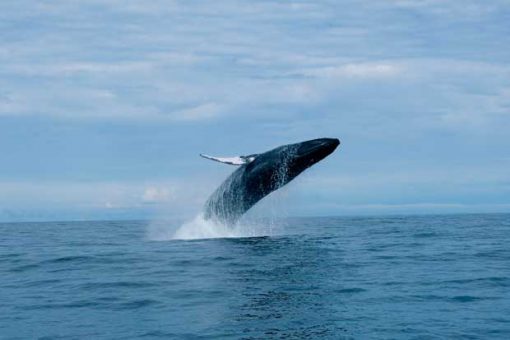
Rhythmic chatter
The afternoon is much less relaxing. I’m thrashing through the humid jungle in a sundress and wellies, spending almost as much time sitting in the red mud with my feet caught in tubular roots as walking upright. Negro, a young guide from El Cantil, seems genuinely embarrassed for me; he suggested this hike as an easy, scenic detour en route to the village of Termales. But I have no legs for the jungle, so he constantly has to stop, tuck his machete into his belt, and help me navigate the smallest incline or obstacle.
Despite this strain on both of us, the jungle is a revelation. It’s full of frogs the size of fingernails and multicoloured crabs the size of fists. At one point, Negro gently picks up a giant ant between thumb and forefinger and holds it to my ear so I can hear its rhythmic chatter. “Reggaeton,” he jokes, doing a quick two-step. Negro helps me tune into the pulse of the jungle, from the buzzing cicadas to the howler monkeys whooping in the distance. Flapping past our noses are giant iridescent blue butterflies that I know are rare because, growing up, I was morbidly fascinated by one I’d been given as a gift — on a pin, in a frame.
Chocó is one of the most biodiverse regions in the world; although it takes up just 1.4% of the Earth’s surface, it contains 60% of all known plant and animal species — a quarter of which are endemic. At each turn, Negro shows me trees with medicinal properties, others that are used for thatching, and some that are thought to be lucky (“Make a wish on this one!”). Or, in the case of the walking tree, one that sprouts new stilt-like roots to move into better light. If I hadn’t seen it, I wouldn’t have believed it could exist.
“The Amazon is famous, but this is the world’s lungs too,” Negro says. “That’s the thing about us Chocoanos, we like simple things; we’re the happiest people in Colombia. But above all, we value this paradise — it’s our livelihoods, our inheritance, the gift we give our children. We want to protect it.”
I’m secretly hoping we might come across a golden poison frog (ideally at a distance); they live only in these parts and are carry enough poison to kill 10 men. The indigenous Emberá people, who still live in the protected reserves of nearby Utría National Natural Park, have used the frogs’ venom on the tips of their blow darts for centuries. But, perhaps fortunately, the amphibians are elusive today. Once we reach a shallow river, where I finally wash off all the mud, we follow it out of the jungle onto yet another deserted stretch of shore.
Several beaches later, we stroll into Termales, an Afro-Colombian village with candy-coloured wooden houses laid out along a sandy path. We’ve arrived during siesta time, so we meet only teens carrying surfboards and a few older folk who emerge through bead curtains onto their porches and greet Negro like family. “Everyone knows everyone around here,” he shrugs.
The hot springs that give the village its name bubble up beside a stream, and Negro leaves me to grind a face mask from volcanic pebbles, soak in the soft water alongside a handful of Colombian tourists and examine the bruises blossoming on my skin.
After the deluge
Two hours down the coast, in the fishing town of El Valle, the music of the jungle is replaced with catchy beats from booming speakers. “We like to dance. All day, from first thing in the morning,” Kiké — a friend I made while dining in his family’s beachfront restaurant — explains to me with an illustrative shimmy. From every other window, residents blast out mixtapes of their favourite genres — champeta, cumbia, reggaeton, currulao, pop. It means that even when the only street activity is kids playing marbles, or a man getting a haircut in a chair outside the barber’s house, El Valle feels like it’s gearing up for a party — which, often, it is.
I’m staying a short walk away from town, by the next beach, Playa El Almejal, where a thin border of rustic cabins and a few upmarket lodges separate a wide beach strewn with driftwood from the wild interior.
For the first time since I got to the Pacific, I’m aware of other travellers in the vicinity. Not many, though — visitor numbers to these parts are so low they’re barely counted — and foreigners are still a bit of a novelty. Out walking one day in El Valle, I’m invited into a living room to watch a World Cup match, and a group of friends teach me to curse like a sailor each time the satellite feed cuts out. Another day, I’m welcomed to a campfire party and offered viche, the Pacific coast moonshine — the only liquor I’ve ever tasted that gets worse with each swig.
Towards the end of my trip, Kiké takes me down the coast in his boat to swim in El Tigre waterfall. Along for the ride is his dad, Nativo — so called because he’s the last Afro-Colombian not to have sold his land on El Almejal beach to rich, out-of-state paisas (Colombians of Spanish descent). The land was too hard won, Nativo explains. “Our ancestors fled slavery in the Spanish gold mines and walked for weeks through the jungle to this coast,” he says.
After loosening up our shoulder muscles under El Tigre’s torrents, we exit the jungle and are instantly hit by delicious, smokey wafts of cooking. We’re not alone on the beach. A group of barefoot men, women and children have emerged from the jungle and are squatting around a freshly dug fire pit. A woman stands and beckon us over.
The first thing that strikes me about Diana is her deep laughter lines. The second is that she’s nursing a roly-poly baby while simultaneously stirring a cauldron. The third is that she’s smothered in what looks like mottled, blue-black ink. In fact, her whole family look like they’ve been attacked by a squid: from her husband (his elbow propped on a fisherman’s trident) to her boisterous brood of five children and their striking grandmother. The women and girls are all wearing patterned sarongs and strings of beads. This Emberá family are en route back to El Brazo, their village deep in Utría National Park. A few hours later, after a lunch of grilled tuna, plantain and boiled snails, which we pick from their shells with a large thorn, I’m invited to visit them there the next day.
Bright and early, Didier, Diana’s 14-year-old son, picks me up in a motorised wooden canoe. The sky is threatening a downpour as we head two hours upriver; the riverbanks overflowing with tropical blooms and fruit trees, between which colourful birds flit. Eventually, El Brazo comes into a sight: a collection of stilted, multistorey huts on a bend in the river, backed by steamy jungle.
It’s a quiet day in the village; we encounter more chickens than people. Diana’s eldest daughter, Deifini, welcomes us into the family home, explaining that if we’d visited a week later, the tambo (a round, conical-roofed meeting hall) would have been filled with dancing, drum music and traditional costumes. “Every year, the village picks a festival queen, and this year it’s going to be me,” she says.
In the lean-to kitchen, under the off-putting stares of mounted animal skulls, Deifini shows me how to peel, grate and strain the juice from unripe jagua, a fist-sized fruit with mottled green, fibrous white flesh and a pulpy core of seeds. This is an almost daily ritual for Emberá women; the potion is used as a sunscreen (which explains the family’s inky tincture the day before) as well as for beautification. Deifini takes a wooden stick and delicately paints a cuff on my arm in the geometric Emberá style. It’s a natural tattoo that lasts for nearly a month. On the day of the festival, the best jagua painters will decorate her legs, arms and chest all the way up to her lower jaw, and she’ll don her mother’s most ostentatious beads.
We spend the afternoon sheltering from the rain, and then, when it stops, pile into the canoe to go home. Deifini chases after us and jumps in too at the last moment. She’s rinsed her hair with the remaining jagua juice to blacken it, and now, as the heavens open again, black rivulets run down her neck and shoulders.
The Emberá children tip me off about a family-run hostel and turtle sanctuary on the largely uninhabited Playa Cuevita. So the next morning I pack a bag and follow the coast south from El Valle, heading through the town’s neat graveyard and along a seemingly endless beach dotted with marine curios: pretty shells, flotsam from wrecks, and even the bones of a small shark, picked clean by gulls. It’s a sweltering, two-hour walk. When I see a sign reading ‘Mama Orbe Family Eco Farm’ poking out from the trees, I feel like a desert survivor reaching an oasis. Mama Orbe, a softly spoken, large-bosomed woman, sets about making me a bed, and then, as night wraps our jungle clearing in velvety blackness, she prepares dinner for her young grandchildren and me, which we wolf down by a beach bonfire.
At dawn, Mama Orbe and Dario, her son, meet me on the beach. Dario’s carrying a sand-filled bucket containing baby turtles that have recently hatched in the enclosure he’s built to protect newly laid eggs from predators. He draws a starting line in the sand and sets the turtles off. They flap their tiny flippers and drag themselves towards the crashing waves of the world’s largest ocean. I watch and wait until each turtle has successfully tackled the surf and bobbed into the distance. Then I sit, toes buried in the dark sand of the empty volcanic beach, feeling blissfully marooned, and watch the horizon for whales, hoping for one more miracle.
ESSENTIALS
Getting there & around
Numerous airlines fly indirectly from the UK to Medellín. From there, Satena and Ada airlines serve Nuquí and Bahía Solano. Luggage is capped at 15kg per person and a tourist tax of COP 8,000 (£2) is levied on arrival in Nuquí and departure from Bahía Solano.
Average flight time: 1h from Medellín
In Nuquí, ferries are infrequent, so a private motor boat is needed to get to Guachalito (40 mins) or El Valle (2 hrs). From El Valle, a bumpy, nine-mile road leads to Bahía Solano (1 hr), serviced by taxis. Ask your hotel or tour operator to arrange transfers. Very little English is spoken, so some Spanish is helpful.
When to go
Chocó province has a tropical, humid climate year-round, with an average temperature of 26C. It’s one of the wettest places on Earth: most days include a brief downpour, although rainfall lessens January-March. The whale-watching season runs from July to October, and olive ridley sea turtle nesting peaks September-December.
More info
Lonely Planet Colombia (2018). RRP: £17.99
colombia.travel
How to do it
Audley Travel offers a week in Colombia from £2,060 per person. Includes two nights at El Cantil Ecolodge in Nuquí with whale-watching; two nights in Medellín with a city tour; and three nights at Hacienda Bambusa in the coffee region, all B&B. Also includes all flights and transfers.
Published in the Jan/Feb 2019 issue of National Geographic Traveller (UK)





